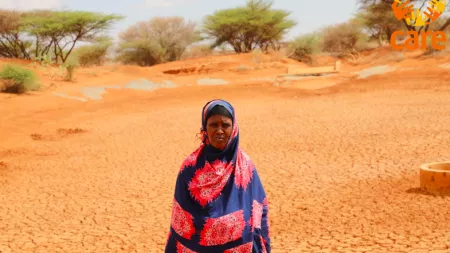Mogadishu: A new CARE survey of over 2,000 households finds that women and girls still remain amongst the most affected by the multiple crises facing the country.
The CARE survey – carried out across five different administrative regions in July 2021 - shows that 77.5% of communities reported that ongoing drought was their biggest challenge, closely followed by COVID-19 (identified by 72%).
Halima*-a 32-year-old mother who was displaced by the 2017 drought lost her mother to COVID-19, her husband left home to look for jobs and never came back, leaving her to take care of their four children.
“The loss of my mother to COVID-19 was the most painful situation and now as a single mother with four kids and no support, it’s very hard to earn a living and look after my children… sometimes we eat, sometimes we stay hungry, this is how life is.” Said Halima
As a result of the drought and COVID-19 induced economic challenges, reports of girls dropping out of school and increase in cases of female genital mutilation have become more widespread. Gender-based violence also remains pervasive, with 33.9% of women and girls living in settlements reporting sexual violence as their biggest concern, followed by inability to access services and resources (27.3%), then violence in homes (25.7%).
Hamda* a 24-year-old woman has been struggling to restart her business which was destroyed by the 2020 floods. The COVID-19 pandemic made it even more difficult for her as she was relying on support from her relatives who work abroad, due to global lockdowns, her relatives stopped providing support.
Hamda* said: “The combination of floods and COVID-19 has made life even more difficult, we need immediate support like food vouchers, shelter for the internally displaced people, capital for those who lost their businesses during the floods, health support and protection for everyone especially women and girls.”
The CARE survey also showed that entrenched gender norms continue to prevail in Somali society, with only 27% of the female-headed-households surveyed having received any form of formal education (compared to 41% of men). It also highlights the inequalities that persist in gendered roles with over 60% of men and women surveyed responding that certain types of jobs such as nursing and cooking should only be carried out by women and that women cannot be strong community leaders.
CARE is calling for prioritization in supporting communities to start self-help groups and invest in augmenting existing women’s groups with livelihood trainings. With the current drought and locust invasions that are threatening to deepen the crisis in an already fragile environment, there is great need for donor/government agencies to extend the much needed humanitarian assistance to the affected communities especially Internally Displaced Persons, pastoralists and vulnerable host communities.
*Names changed for protection reasons
About CARE Somalia
Founded in 1945 with the creation of the CARE Package®, CARE is a leading humanitarian organization fighting global poverty. CARE places special focus on working alongside women and girls. Equipped with the proper resources women and girls have the power to lift whole families and entire communities out of poverty. In 2020, CARE worked in over 100 countries, reaching more than 90 million people through 1,300 projects. To learn more, visit www.care.org
In Somalia, CARE is committed to advancing gender equality through its development and humanitarian programs. The programs are tailor made to discourage negative cultural norms whilst promoting equality.
Notes to Editor
The CARE Rapid Gender Assessment was conducted in Banadir, Puntland, SouthWest state, Somaliland and Galmudug, and a total of 2,437 respondents were interviewed including 72.5% female and 27.5% male. The assessment covered host communities (54%), internally displaced persons (45%) and returnees (1%). Some key findings of the Assessment include:
Current priority livelihoods and income sources for both men and women include casual labor (38.6%), followed by petty trade (30.1%), livestock (23.6%), farming (13.5%) while 20% had no paid activities. The assessment found that there are more women with no livelihood/income source (22.3%) compared to men (13.6%), which clearly shows that gender disparity exists against women when one looks at access to livelihoods sources.
The majority, of the households (74.4%) surveyed, claimed not to have received humanitarian assistance 30 days preceding the assessment however, among those receiving the assistance a majority were female headed (65.1%).
A large portion (60.3%) of the communities surveyed believe that some duties can only be performed by a specific gender, for example they believe men cannot be nurses or cooks and women cannot be strong community leaders. Notably, more female respondents (62.4%) support this belief compared to male (54.9%). There is also a strong belief that women in the community are not fully heard; with 60% of the respondents feeling that some women are suppressed by society and forced to live up to their gender roles while others have a few of their rights respected and their voices heard.
There is some level of women involvement in decision- making for key social and economic aspects of household through joint decision-making and being consulted by spouses, though men still dominate the decision-making arena in households. Information shows that in majority of cases men solely decide on who works for money in the household (61.7% for men VS. 36.9% for female), buying and selling assets (40.2% for men VS. 28.5%), migration/displacement (31% for men Vs. 20% for women), and accessing health care for children (28.6% for men Vs. 27.6% for women).
